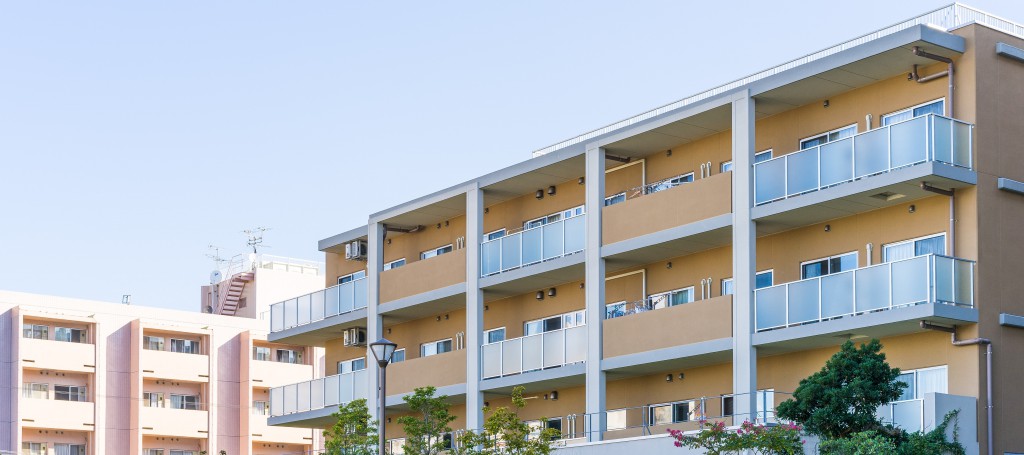REPORT

Research & Insights
Reasons for mass production of unmarketable civil service housing
On April 19, 2021, I participated in a panel discussion titled "The Possibility of Defense Facilities Development with Private Funds (Part 2)" held by the Society for Defense Facilities Studies. As its name suggests, the Japan Society for Defense Facilities Studies is an organization established to promote the emergence and development of technologies related to defense facilities, such as construction engineering, natural science, and military engineering.
The Ministry of Defense and the Self-Defense Forces have 24,000 buildings, including government buildings, hangars, and warehouses, in addition to basic facilities for the operation and training of various equipment, such as airfields, port facilities, and training grounds. About 5,000 of these buildings are more than 50 years old and are seriously deteriorating. Considering that the number of aging facilities will increase with each passing year, it is necessary to rebuild or renovate them as soon as possible. In doing so, I spoke from the perspective of how we should utilize private funds and private sector know-how.
In this forum, we talked about the Military Housing Privatization Initiative (MHPI), a program introduced by the U.S. military.
The MHPI was launched in 1996 as a tool to improve the living environment of military housing. In order to efficiently provide high-quality military housing, MHPI enters into 50-year land and building lease contracts with private developers and entrusts the development and maintenance of housing to private operators. To date, about 200,000 units have been renovated and maintained, and considering that about 180,000 units were in need of renovation as of 1996, the renovation target has already been met.
What's interesting about MHPI is that it can be rented to non-military people, depending on occupancy rates, in order to ensure rent stability.
Lending to civilians improves the quality of military housing.
The main source of revenue for private businesses is the Basic Allowance for Housing (BAH) paid to military personnel by the armed forces (land, sea and air), and the investment is recovered based on rental income. However, there is no compensation for vacancies or non-payment, and there is no obligation for military personnel to move into military housing. In other words, the private operator is always exposed to the risk of fluctuations in earnings due to the formation and retirement of the military. Therefore, in order to reduce the risk for private operators, the MHPI allows them to rent to non-military civilians depending on the occupancy rate.
For example, the Air Force can rent to federal employees and former military households if the property is vacant for 30 days, to DoD employees if the property is vacant for 60 days, and to civilians if the property is vacant for 90 days.
If you look at the 34 Army projects that are covered by the MHPI, 73 percent of the projects lease their properties to civilians. 73% of the Army's 34 projects that are covered by the MHPI have leased their properties to civilians. That is how many civilians are being provided military housing.
And this institutional design of "allowing civilians to rent" is the crux of the quality improvement of military housing.
As I mentioned earlier, the vacancy rate for military housing fluctuates depending on the composition of the military and the number of retirees. In the unfortunate event that a dwelling unit becomes vacant, it must eventually be rented out to civilians. At that time, if the layout and specifications of the military housing are inferior to those of other civilian housing, there will be no one to rent. In other words, private operators must create units that are as good as the surrounding private housing.
Of course, the U.S. military, which provides the funds, would want private businesses to build housing at the lowest possible cost. However, if they eliminate costs and build low-quality housing, the value of the housing will decline. If that is the case, even if the cost increases a little, it would be better to build housing that is comparable to private-sector housing and with specifications that can compete in the private-sector rental market. The U.S. military is not obligated to deal with vacancies or non-payment, so the idea is to give private businesses a certain degree of freedom so that they can make a profit.
This is an idea that is the opposite of Japan's.
The Self-Defense Forces dormitory is old, narrow, and the facilities are a long time ago.
In the case of Japan, Self-Defense Force quarters are fully financed by the government. In the current era of tight national finances, when building or renovating quarters, they tend to have smaller floor plans and lower specifications in order to reduce waste or to persuade the Ministry of Finance. This can be said of public servants' quarters in general. However, although the initial cost can be reduced, the resulting building will not be competitive in the market.
If you look at the reality of SDF housing, you will find that it is old, cramped, and equipped with old-fashioned facilities that civilians would not want to pay to rent. If young people who join the SDF to protect the country live in such housing, it will affect their morale, and in the medium to long term, the number of young people who want to join the SDF will decrease.
Many of the facilities related to the Ministry of Defense and the Self-Defense Forces are directly related to security, but it is safe to say that accommodation has little to do with them. If the government does not have the budget, I think it should make use of private sector funds and know-how to create world class properties.
その他のレポート|カテゴリから探す